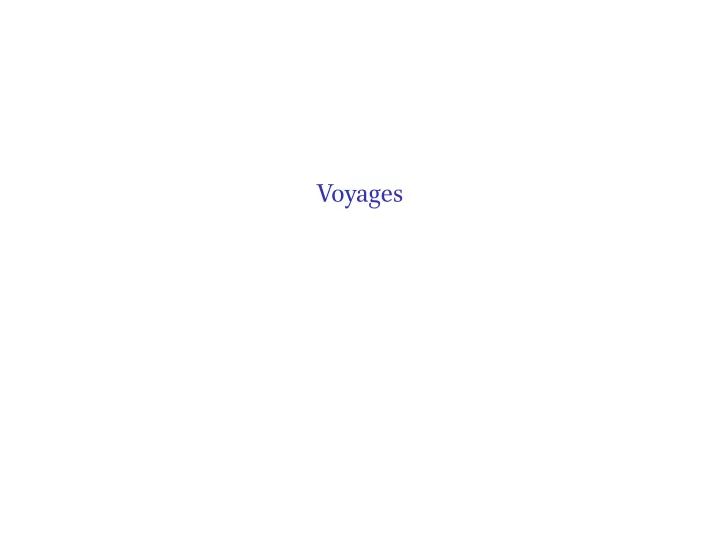

Voyages
Exam: Seen Texts ▶ Craigie 1 ▶ Craigie 3 down to “settu þeir dverg” ▶ Craigie 4–5 ▶ Craigie 13: translation down to “hljótt mæði kveða”, content of rest ▶ Craigie 14–16 ▶ Craigie 18: translation down to “sætt af hendi Heðins”; content of rest ▶ Eiríks saga víðfǫrla : However far we get
Contacts Figure: “Allah Ring”, Birka (CC-BY Gabriel Hildebrand)
Movements Figure: Territories and Voyages (CC-BY-SA Bogdan Giuşcă)
Periodization of Viking Incursions in England Northumbria Battle of Stamford 1066 England Danes govern 1016–1042 attacks Second wave of 980–1016 Scandinavians governed by 939–954 Figure: Danelaw (CC-BY-SA WMC user) Norse areas Wessex captures 899–927 established attacks; Danelaw First wave of 835–886 Northumbria Dorset, Lindisfarne, Sporadic accounts: 787–794 Bridge
Could Some of These Have Been Contributing Factors? Push Pull Necessary Conditions ▶ Agricultural overpopulation ▶ Wealth ▶ Political exile ▶ (Women) ▶ Estate overpopulation ▶ Social prestige ▶ Shortage of women ▶ Seaworthy ships ▶ Favourable climate
Motivations: The Example of Haraldr hárfagr “ When he had taken possession of regions that had newly come into his power, King Haraldr was very wary about landed men and powerful farmers and all those about whom he had misgivings that some sort of uprising was to be expected of them. He made them all do one or the other: join his service or leave the country; but the third option was to suffer harsh treatment or death, and some were maimed in their hands or feet. ( Egils saga ch. 4) ”
The Viking Longship Figure: Oseberg Longship (CC-BY-SA: Flickr user)
Ohthere “ Figure: Scandinavia ” ” Two Voyagers , 18–19) the coast as far as he could sail in there he sailed due south along did not know which. Then from or the sea penetrated the land he there the land turned due south, for a due northern wind, because coast as far as he could sail in and then sailed east along the there for a west-north-west wind, the land he did not know which due east, or the sea penetrated three days. There the land turned far as he could reach in the second He then continued due north as (CC-BY-SA WMC user) — but he knew that he waited four days. There he had to wait five days. ( Orosius 1.1, trans. Lund,
The Viking Longship Figure: Clinker-Building (public domain / WMC user)
The Viking Longship Figure: Oseberg Longship (CC-BY-SA: Flickr user)
Climate History Figure: Medieval Warm Period and Little Ice Age (CC-BY-SA: Robert A. Rohde)
Movements Figure: Territories and Voyages (CC-BY-SA Bogdan Giuşcă)
Greenland Figure: Eastern Settlement (CC-BY-SA WMC user)
Greenland Figure: Western Settlement (CC-BY-SA WMC user)
Greenland Figure: Hvalsey Church, Eastern Settlement (CC0 WMC user)
North America Figure: L’anse aux Meadows, Newfoundland (public domain / WMC user)
North America Figure: L’anse aux Meadows, reconstruction (CC-BY Panoramio user)
Travel Literature, Cosmography, Ethnography east, commonly inhabited by giants or finnar Figure: Reconstructed world view (from Simek, “Elusive Elysia,” 271) ▶ Legendary sagas: journeys to distand lands, esp. in the north and ▶ Marvels of the East ▶ Itineraries, e.g. of the way to Rome or Jerusalem
Voyages to the New World Figure: Voyages according to the sagas (CC-BY-SA WMC user)
Bibliography I Barraclough, Eleanor Rosamund. Beyond the Northlands: Viking Voyages and the Old Norse Sagas . Oxford: Oxford University Press, 2016. Kunz, Keneva, trans. The Vinland Sagas . London: Penguin, 2008. Lund, Niels, ed. Two Voyagers at the Court of King Alfred: The Ventures of Ohthere and Wulfstan . Translated by Christine E. Fell. York: Sessions, 1984. Simek, Rudolf. Altnordische Kosmographie: Studien und Quellen zu Weltbild und Weltbeschreibung in Norwegen und Island vom 12. bis zum 14. Jahrhundert . Ergänzungsbände zum Reallexikon der Germanischen Altertumskunde 4. Berlin and New York: De Gruyter, 1990.
Bibliography II Simek, Rudolf. “Elusive Elysia; or, Which Way to Glæsisvellir?: On the Geography of the North in Icelandic Legendary Fiction.” In Sagnaskemmtum: Studies in Honour of Hermann Pálsson , edited by Rudolf Simek, Jónas Kristjánsson, and Hans Bekker-Nielsen, 247–275. Vienna, Köln, and Graz: Hermann Böhlaus, 1986.
Recommend
More recommend